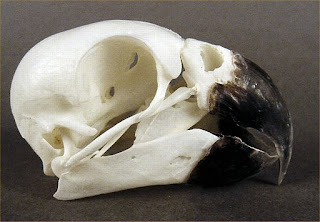What makes a parrot a parrot?
written by Nick Sly
For all their diversity, parrots are instantly recognizable. Just compare such varied species as the Kakapo, the Hyacinth Macaw, a Racquet-tail, a Cockatoo, and a Lory.
What unites them?
Wild differences in size, shape, and coloration are glaring, but they still share distinct morphological features. These features, a product of parrot’s common ancestry and evolution, define them as a unique group of birds in their own order, the Psittaciformes.
The most recognizable feature that unites parrots is their bill. The parrot bill is a short, broad, with a strongly curved upper mandible that hooks around the shorter lower mandible. For an excellent comparison of a wide range of parrot skulls and bills, check out http://www.skullsite.com/ (search for Psittaciformes). Compare parrot skulls with those of the raptors (Falconiformes), which also have hooked bills.
The hooked bill reaches its most extreme with the massive maw of the Hyacinth Macaw Anodorhynchus hyacinthinus, while it is more subdued in the lories, budgerigar, and other small species such as the Green-rumped Parrotlet.
The parrot bill is given extra mobility by a flexible hinge between the skull and the upper mandible. This enables a parrot to wield extra force in biting. The parrot’s bill morphology is used to crush or husk hard seeds and fruit, with the lower mandible acting as a shearing edge.
Source: 10000birds.com
Skeleton of a parrot and skull of a cockatoo.
Date: 1894-95
Source: Royal Natural History Vol 3
Author: R. Lydekker
Agapornis Personatus
photo by: www.skullsite.com
Amazona Aestiva
photo by: www.skullsite.com
Psittacus Erithacus
photo by: www.skullsite.com
Ara Chloroptera
photo by: www.skullsite.com
Psittacus Erithacus
photo by: www.skullsite.com
link: Bird Skull Collction
link: 3D Hyacint Macaw Skeleton
link: Bird skull photographs: family Psittacidae
link: Bird skull photographs: family Cacatuidae






